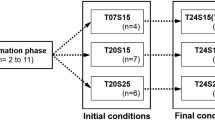Summary
An experimental study of the copepod Mesocyclops edax documented that females which reproduced throughout their lifetime survived at a lower rate than unmated females which did not reproduce. This cost of reproduction was most apparent in animals receiving periodic, non-lethal temperature stress. However, among reproductive females, no significant correlations were detected between reproductive output and survival, suggesting caution concerning the application of cost of reproduction arguments to a population of females in which clutch size is seen to vary.
Similar content being viewed by others
References
Bell Graham (1980) The costs of reproduction and their consequences. Amer Natur 116:45–76
Browne RA (1982) The costs of reproduction in brine shrimp. Ecology 63:43–47
Clarke KU, Sardesai JB (1959) An analysis of the effects of temperature upon growth and reproduction of Dysdercus fasciatus Sign (Hemiptera, Pyrrhocoridae). Bull Entomol Res 50:387–405
D'Agostino AS, Provasoli L (1970) Dixenic culture of Daphnia magna Straus. Biol Bull 139:485–494
Dean JM (1981) The relationship between life span and reproduction in the grasshopper Melanopus. Oecologia 48:385–388
Giesel JT, Murphy PA, Manlove MN (1982) The influence of temperature on genetic interrelationships of life history traits in a population of Drosophila melanogaster: what tangled data sets we weave. Amer Natur 119:464–479
Giesel JT, Zettler EE (1980) Genetic correlations among life historical parameters and certain fitness indices in D. melanogaster: rm, rs and diet breadh. Oecologia 47:299–302
Hochachka PW, Somero GN (1973) Strategies of Biochemical Adaptation. W.B. Saunders, Philadelphia
Leggett WC, Carscadden JE (1978) Latitudinal variation in reproductive characteristics of American shad (Alosa sapidissima): evidence for population-specific life history stretegies in fish. J Fish Res Board Can 35:1469–1478
Murdoch WW (1966) Population stability and life history phenomena. Amer Natur 100:45–51
Murphy JS (1970) A general method for the monoxenic cultivation of the Daphnidae. Biol Bull 139:321–332
Smith JNM (1981) Does high fecundity reduce survival in song sparrows? Evolution 35:1142–1148
Snell TW, King CE (1977) Lifespan and fecundity patterns in rotifers: the cost of reproduction. Evolution 31:882–890
Sokal RR, Rohlf FJ (1969) Biometry. W.H. Freeman, San Francisco
Stearns SC (1976) Life-history tactics: a review of the ideas. Q Rev Biol 51:3–47
Tallamy DW, Denno RF (1982) Life history trade-offs in Gargaphia solani (Hemiptera: Tinidae): the cost of reproduction. Ecology 63:616–620
Author information
Authors and Affiliations
Rights and permissions
About this article
Cite this article
Feifarek, B.P., Wyngaard, G.A. & David Allan, J. The cost of reproduction in a freshwater copepod. Oecologia 56, 166–168 (1983). https://doi.org/10.1007/BF00379687
Received:
Issue Date:
DOI: https://doi.org/10.1007/BF00379687




